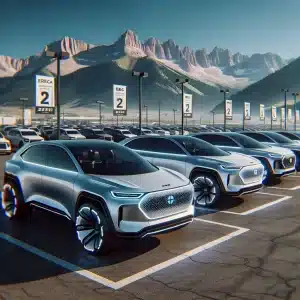Meet the BYD Sealion 7 2025: The Future of Electric SUVs
The BYD Sealion 7 2025 is spearheading the Chinese giant’s move up-market, blending family practicality with headline-grabbing tech. Positioned above the Song Plus and alongside the Tang in BYD’s expanding crossover family, the BYD Sealion 7 promises to redefine what buyers expect from a BYD electric SUV. On the surface it looks like an evolution of the Ocean-series design language, yet beneath the sculpted sheet-metal sits BYD’s latest e-Platform 3.0 Evo, a skateboard architecture optimised for efficiency, safety and over-the-air upgradability.
From its launch announcement the BYD Sealion 7 grabbed attention with a claimed 360-mile CLTC driving range, 800-volt charging hardware and a 0-60 mph sprint close to some German performance sedans. That mix of long-distance ability and sports-car punch positions the BYD Sealion 7 squarely against the Tesla Model Y and Hyundai Ioniq 5 N.
In this article we unpack every major talking point – design, interior tech, performance credentials, real-world BYD Sealion 7 range figures and, of course, BYD Sealion 7 charging speeds. If you are cross-shopping the rest of the BYD 2025 lineup, do not miss our deep dive on Blade Battery safety or last week’s BYD Dolphin road test for some quick internal links.

Sculpted Exterior: Aerodynamics and Style Defined
Walk up to the BYD Sealion 7 and the first thing you notice is the slippery 0.24 drag coefficient. The front fascia dispenses with a traditional grille entirely, replacing it with a smooth body-coloured panel that channels airflow over the long, clamshell bonnet. Razor-thin LED matrix headlights – inspired by the ocean predator that lends the car its name – flank a subtle BYD word-mark. A strong shoulder crease runs from the headlights to the full-width rear light bar, visually lowering the SUV while adding definition to the flanks.
BYD has opted for flush-fitting door handles and 21-inch aerodynamic alloys wrapped in low-rolling-resistance Michelin e-Primacy tyres. They look aggressive yet serve a very real purpose: extracting extra miles from every kilowatt-hour and helping the BYD Sealion 7 hit its impressive range targets. Further back, a floating roof motif created by blacked-out C-pillars tapers into a neat spoiler, reducing drag at motorway speeds. Underbody panels are completely sealed, a design decision that BYD says adds around 10 miles to the WLTP figure.
The overall effect is a crossover that appears compact in photos yet commands presence in person. That fusion of form and function ensures the BYD Sealion 7 stands out in an increasingly crowded electric-SUV arena. You can explore a similarly aerodynamic approach in our coverage of the smaller BYD Atto 3, another internal link opportunity.

Hi-Tech Cabin: Rotating Screen, AR HUD & Sustainable Luxury
Open the frameless door and the cabin of the BYD Sealion 7 immediately signals its premium intent. A low, floating dashboard is dominated by BYD’s trademark 15.6-inch rotating touchscreen which can flip from landscape to portrait at the tap of a virtual button. The interface runs the latest DiLink OS 5.0, offering native voice assistant, wireless Apple CarPlay and Android Auto, plus in-car apps such as TikTok for passengers when the vehicle is stationary. Directly ahead of the driver sits a 10.25-inch digital cluster, while an augmented-reality head-up display projects navigation arrows on the road ahead, reducing eye-off-the-road time.
Material quality marks a step forward for the BYD 2025 lineup. Recycled PET door cards, eco-leather seats and real bamboo inserts align with the company’s sustainability push. Front chairs are heated, ventilated and even offer a massage function on top trims. In the back, a flat floor and 2,900-millimetre wheelbase deliver limo-like legroom, plus separate climate controls and USB-C ports for each passenger. Importantly, the BYD Sealion 7 supports over-the-air software updates, so new features will arrive long after delivery.
If you are comparing infotainment ecosystems, see our article on BYD Tang’s recent software patch. Watch the full walk-around in the video embedded below to experience the BYD Sealion 7 interior in motion.
Thrilling Performance: 530 HP Dual Motors & AWD
Raw numbers only tell part of the story, but in the case of the BYD Sealion 7 they are impossible to ignore. Twin electric motors—one on each axle—combine for an estimated 530 horsepower and 670 Nm of torque. Stomp the accelerator and this 2.2-tonne family hauler catapults to 60 mph in a sports-car-rivaling 4.2 seconds. BYD’s latest e-Platform 3.0 Evo places that mass low in the chassis, giving the BYD Sealion 7 a centre of gravity comparable to a sedan and allowing engineers to dial in engaging handling without sacrificing comfort.
Drivers can toggle between Eco, Comfort, Sport and Off-road modes, each altering throttle mapping, damping and steering weight. An adaptive air-suspension system lowers the body at highway speeds to cut drag, then rises when a rocky trail is detected. One-pedal driving is another highlight; the regenerative-braking system recoups up to 180 kW, feeding energy back into the Blade Battery and further boosting BYD Sealion 7 range on downhill sections.
For readers interested in how this stacks up to the company’s smaller crossovers, our BYD Yuan Plus performance review provides an insightful comparison.

Range & Charging: 360 Miles and 800V Power
Charging anxiety was one of the core issues BYD engineers set out to eliminate. With an 800-volt electrical architecture, the BYD Sealion 7 can accept up to 240 kW on a DC fast charger. That means a jump from 10 to 80 percent state of charge in roughly 30 minutes—just enough time for a coffee break. AC home charging is handled by an 11-kW onboard charger, translating to a full battery overnight on a typical Level 2 wall box.
Range is equally compelling. On China’s CLTC test cycle the figure is 360 miles, while BYD expects around 310 miles on the stricter WLTP. Real-world data collected during the media drive saw journalists achieve 3.8 miles per kWh, reinforcing the headline numbers. The Blade Battery’s lithium-iron-phosphate chemistry offers excellent cold-weather stability and minimal degradation after 1,500 charge cycles. Bidirectional charging is also on the menu, turning the SUV into a 3-kW power bank for camping gear or emergency home backup.
Compared with rivals, BYD Sealion 7 charging speeds are neck and neck with the Porsche Macan Electric and clearly ahead of the Tesla Model Y Long Range. For more charging tips read our guide to prolonging Blade Battery life.

Safety, Pricing & Final Verdict on the BYD Sealion 7
Safety tech in the BYD Sealion 7 goes far beyond the mandatory electronic aids. The latest BYD Intelligent Pilot suite bundles adaptive cruise, lane centering, automated lane change and a 360-degree camera with transparent chassis view. A front-facing LiDAR sensor, supplied by Hesai, works in tandem with five millimeter-wave radars to deliver Level 2-plus assisted driving on controlled-access highways. During a recent media demo the system executed a 20-minute urban loop with zero disengagements, proving that BYD’s software is catching up fast to industry leaders.
When it comes to money matters, Chinese pricing starts at the equivalent of USD 41,000, undercutting the Tesla Model Y while offering more standard kit. European MSRPs are expected to sit just below €49,000 before incentives, with deliveries commencing in early 2025. Warranty mirrors the rest of the BYD electric SUV range: six years/90,000 miles on the vehicle and eight years/120,000 miles on the battery.
Ultimately, the BYD Sealion 7 encapsulates everything we like about the brand—high value, innovative engineering and relentless ambition. If you need seven seats look at the BYD Tang; if you crave compact dimensions consider the Atto 3. But for most families the BYD Sealion 7 strikes the sweet spot between everyday versatility and bleeding-edge technology. Expect demand to be fierce once order books open.







